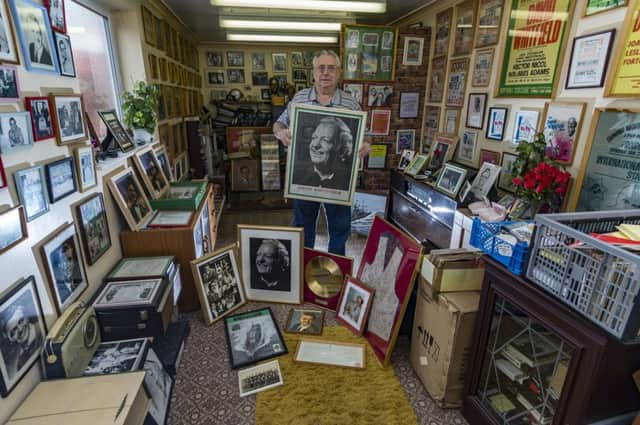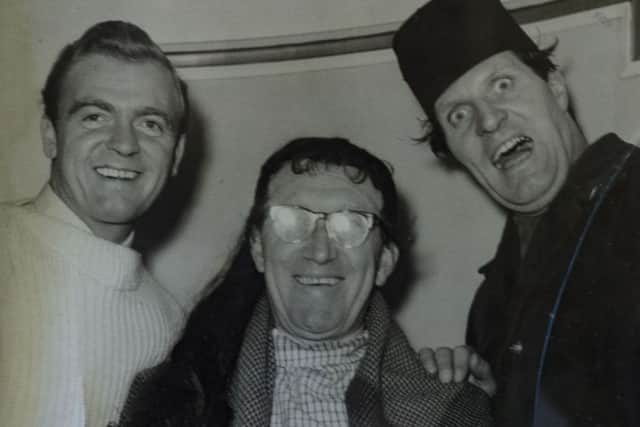Never fade away


“Britain’s tenor with the muscular tonsils”, as he was once none-too-elegantly called, had more records in the Fifties charts than any other British male vocalist and took top billing over Morecambe and Wise.
He had such a successful US career that, long before his early death in 1980, he was offered a Hollywood contract. He said no; he was too attached to Hull. “He never forgot his roots,” says his widow Sheila, who lives in Willerby, on the city’s outskirts. “He was very outgoing, very down to earth.”
Advertisement
Hide AdAdvertisement
Hide AdFour years ago she unveiled a city centre statue of him (which we’ll come to) and there’s also a street – David Whitfield Close – named after him. But his memory is kept most spectacularly alive by Bill Wilkins’ extension: a Whitfield shrine, full of relics.


Bill points out a few treasures. Here’s one of David’s key rings, he says. One of his tie clips; his penknife; the pair of cufflinks he wore for his first appearance on The Ed Sullivan Show; a framed silver waistcoat. Over here is the number plate from his caravan (DW 100). Over there a fragment of lino floor from his bathroom and part of his wrought-iron staircase rail.
Everywhere there are records and photographs: David smiling charmingly; David smoking moodily; David feeding a seal at Dudley zoo; David in hospital autographing a bedpan for adoring nurses.
And theatre bills, plastered across the walls (“and just look up: they’re on the ceiling as well”). Here’s one from a Fifties variety show at the Sheffield Empire (Twice Nightly, 6.15 and 8.30). “The Thrilling Voice of David Whitfield, Britain’s Sensational Singing Star” is right up there at the top.
Advertisement
Hide AdAdvertisement
Hide AdHe shared the bill with Hal Monty (“Laugh and be happy”), Tommy Dale (“Dancing xylophonist”) and The Balloon Man (“Novelty for the kiddies”). It was the dying days of variety; rock and roll was about to sweep into Britain and make Whitfield’s heartfelt balladeering seem suddenly old-fashioned.


As a child, Whitfield, born in 1926, sang in the choir of his home city’s St Peter’s church. He left school at 14, joined the Royal Navy at 17, took part in the D-Day landings and sang in forces’ cabaret shows.
Back in England in 1950, he took part in Opportunity Knocks, the Hughie Green talent show, in its pre-TV days. He was a huge success and went on tour. Things looked promising, but the tour ended after eight months and he got a job as a coalman’s mate.
Green came to his rescue and he made his London stage debut in 1951 and his recording debut with Decca in 1953. Answer Me, a soulful ballad with ringing high-tenor notes, made the top of the charts and sold 700,000 copies.
Advertisement
Hide AdAdvertisement
Hide AdCara Mia – even more ringing – trumped that. With Mantovani’s luscious strings and a celestial-sounding choir, it topped the charts for three months, earning Whitfield a gold disc, the first for a British male singer.
“I heard him singing it on the radio,” says Bill. “I’d never heard a voice like it. And it all took off from there. I bought all his records as they came out. He just had charisma. When he started singing on stage, people went crazy.”
Bill, a retired insurance man, has built up a Whitfield archive of cuttings. Two shelves are crammed with smartly bound files and scrapbooks labelled Recordings, Foreign, Television, In Scotland, In America, Before Decca.
He has hundreds of autographs and hundreds more photographs of Whitfield with his neatly parted hair: in The Desert Song at Leeds Grand in 1962, in his dressing room, on TV (photographed from a broadcast, rather fuzzy). There’s even an autographed picture of him signing autographs.
Advertisement
Hide AdAdvertisement
Hide AdWhitfield sang at the 1954 Royal Variety Show, became the first British artist to break into the American charts and made seven appearances on The Ed Sullivan Show, with audiences of up to 65 million. But the musical mood was changing.
“Rock and roll took over the airwaves,” says Bill. “He wasn’t doing the big dates; he was doing clubs, working every night all over the country.”
Whitfield’s recording career dwindled, but he still appeared in musicals and toured worldwide. He died in 1980 in a Sydney hospital after a brain haemorrhage, aged just 54. His ashes were scattered at sea off Spurn Point.
Some years earlier, Bill, then living in Surrey, had got to know him and, if performing in the area, Whitfield would sometimes stay at his home. “He wouldn’t stay in hotels,” says Bill. “He liked to stay with friends and fans. He was always very friendly; just an ordinary bloke.”
Advertisement
Hide AdAdvertisement
Hide AdHe points to photographs of the pair of them laughing and joking, and of himself performing Whitfield numbers at cabarets in pubs and clubs.
Seven years after the singer’s death, Bill and fellow enthusiasts founded the David Whitfield International Appreciation Society, which at its peak had 300 members (“not a great deal from Hull, funnily enough”).
They campaigned to get a statue erected. Sculpted by Barnsley-based Graham Ibbeson – whose skipping depiction of Eric Morecambe cheers up Morecambe prom – it’s opposite the entrance to Hull’s New Theatre. Whitfield smooches close to the microphone, tilting its stand, leaning into the audience, seducing them into the song.
It’s a vivid reminder of the star quality he never fully exploited. “His manager said he should go to London and live there permanently; he thought he would do better,” says Sheila Whitfield. “But David wouldn’t; he always wanted to live here. He would never move, apart from two years when he was in Rose Marie and The Desert Song.”
Advertisement
Hide AdAdvertisement
Hide AdThe society has had a rose named after him. A couple of dozen of its pinky-red flowers grace the David Whitfield Memorial Garden, alongside a thundering dual carriageway in the city centre. They share a pocket plot with a bed of white roses dedicated to the other Hull-born singer whose career hit its heights in the Fifties, Ronnie Hilton.
Interest in Whitfield has gradually lessened. “Youngsters haven’t heard of him now,” says Bill, adding that these days the museum doesn’t get many visitors. How many? “Possibly a dozen a year.” It’s not among the Hull museums being celebrated in City of Culture year, which to date has no Whitfield-related events.
The society was formally wound up two years ago. “A lot of members are getting older, a lot have died,” says Sheila. It lives on as an informal network of enthusiasts, supporting a fund to pay for statue repairs and contributing memories to its continuing magazine.
In the latest issue, a fan recalls her teenage adoration of Whitfield: “I embroidered his name round the top of my ankle socks and on my blouse sleeves and even used a pin to scratch his initials on my arm!”
As we leave the museum and step back into 2016, I ask Bill to name the most precious exhibit. “It’s all precious,” he says and locks the door. “All of it.”
David Whitfield Museum: 01482 831570.